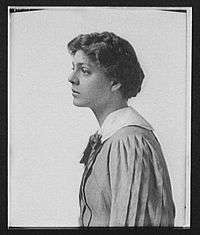That's all there is, there isn't any more

"That's all there is, there isn't any more" was a phrase Ethel Barrymore used to rebuff curtain calls. The line entered the national consciousness of the United States in the 1920s and 1930s and has often been referenced and parodied.[1]
Origins
According to entertainment columnist Sidney Skolsky in March 1931, the line comes from a play Barrymore starred in, Thomas Raceward's Sunday, which opened at New York's Hudson Theatre on November 15, 1904. Barrymore portrayed an eastern girl on a western ranch. In one scene she reads a letter from home, and her line upon finishing a reading of the letter was "That's all there is—there isn't any more."[2] Barrymore would use the line after the play to quiet the thunderous applause beckoning her to do a curtain call. The phrase, which typified Ethel's blunt humor and distaste for attention, became a part of the national language. Ethel herself would parody it in a 1949 Christmas broadcast on Bing Crosby's radio show, though she couldn't finish the line reading without erupting into laughter.[3] Ethel Barrymore's last words were reportedly "Is everybody happy? I know I'm happy. That's all there is, there isn't any more."[4]
References in popular culture
The phrase has been parodied and referenced frequently.[5] In theatre it was most famously quoted in George S. Kaufman and Edna Ferber's The Royal Family, a comedy satirizing the Barrymore family. Examples of film references include the 1933 pre-code Sons of the Desert, where it is quoted. In literature it was the closing line for every book in the children's series Madeline, and it would become the franchise's most famous phrase. References in music include Nat King Cole's "That's All There Is"[6] and Judy Garland's "That's All There Is, There Isn't Any More". Bruce Springsteen was also known to say variations of the lines during his lengthy, concert-ending performances of Gary U.S. Bonds's song "Quarter to Three" on the Darkness Tour in 1978.
See also
References
- ↑ Ethel Barrymore at TCM
- ↑ The Big Apple: "That's all there is—there isn't any more!" (Broadway curtain-call speech)
- ↑
- ↑ "LIFE". Books.google.com. 1959-06-29. p. 116. Retrieved 2015-11-08.
- ↑ Search Results on the Google News Archive for "That's all there is, there isn't any more"
- ↑ That's All There Is Lyrics